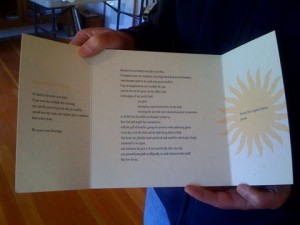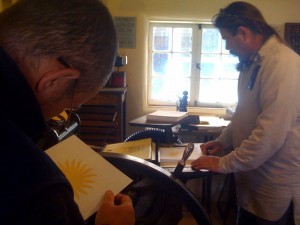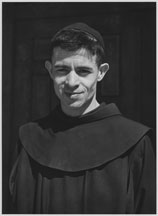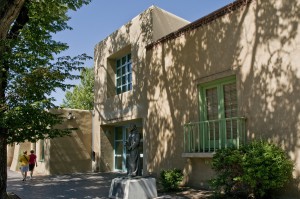In honor of the 100th anniversary of Fray Angélico Chávez’s birth, the History Museum’s Library, which bears his name, will hold a daylong symposium in the auditorium this Saturday. Check out the schedule below. You’re invited. It’s free. And, if you’re among the first 200 to arrive, you’ll receive a commemorative copy of Jimmy Santiago Baca‘s poem written in honor of the friar and hand-printed on the Palace of the Governor’s historic presses.

Tom Leech (left, in photo below) and James Bourland (at press, in photo below), the skilled hands of the Palace Press, produced a stack of the commemorative poems on Tuesday. The sun image on its cover came off of the 1899 Chandler & Price machine once used to produce the fabled Estancia News Herald. The poem was printed on the Vandercook Press in a Bodoni Condensed font.

The poem came about when Tomas Jaehn, director of the Fray Angélico Chávez History Library, decided to ask Baca if he would be willing to write something in honor of the late friar — a renowned historian, author and artist. Baca drew on their shared love for Hispanic culture in crafting his poem, which reads, in part:
… you resemble the sun,
you are here in the grass, on the adobe wall,
in the pages of my poetry book
you glow
redemption, open-hearted love for the land,
warming the air with your vehement passion to announce
to all life how beautiful our Hispanic culture is ….
 The beauty of that culture was threaded throughout Chávez’s life. Born Manuel Ezequiel Chávez in Wagon Mound, N.M., Fray Angélico was ordained as a Franciscan, served several parishes in New Mexico and was instrumental in renovating the church in Peña Blanca – a true hands-on effort. The murals he painted of the Stations of the Cross used images of himself, his family and parishioners. He also renovated churches in Domingo Station, Golden and Cerrillos.
The beauty of that culture was threaded throughout Chávez’s life. Born Manuel Ezequiel Chávez in Wagon Mound, N.M., Fray Angélico was ordained as a Franciscan, served several parishes in New Mexico and was instrumental in renovating the church in Peña Blanca – a true hands-on effort. The murals he painted of the Stations of the Cross used images of himself, his family and parishioners. He also renovated churches in Domingo Station, Golden and Cerrillos.
As an Army chaplain, he was present for the World War II beach landings at Guam and Leyte and, during the Korean War, was stationed at Fort Bliss, Texas, and Kaiserslautern, Germany.
Upon his return, Chávez was appointed archivist of the Archdiocese of Santa Fe, where he catalogued and translated the Church’s Spanish archives. As noted in a biography on the Web site of the New Mexico Office of the State Historian:
While digging for the golden nuggets of Franciscan history in the archdiocesan archives, he instead came across baptismal, marriage, and death records that revealed much about the families who had settled the region. He wrote: “It was like the case of a miner who sifted a hill of ore for gold, setting aside any silver he encountered; in the end the silver far outweighed the gold. The only thing to do was to render the silver useful.” He compiled the silver and published the Origins of New Mexico Families: A Genealogy of the Spanish Colonial Period in 1954. Genealogists searching for their familial roots have found the book invaluable.
Chávez is perhaps best known for writing La Conquistadora, the Autobiography of an Ancient Statue about the figure of the Virgin Mary revered by parishioners of St. Francis Cathedral in Santa Fe. He also wrote short stories, novels and poetry. T.S. Eliot called his poem, The Virgin of Port Lligat in 1959 a “very commendable achievement.”
 After his death in 1996, the History Library was named in his honor, and a bronze statue of him graces its entrance. A self-portrait is on display in the Palace of the Governors’ Portrait Gallery, and it carries an interesting tale. Painted in 1939 as an “idle sketch” on a board by Fray Angélico in 1939, it was later trimmed down to repair a drawer in the convent at Peña Blanca. In 1970, someone cleaning out the drawers happened upon it. Fray Angélico donated it to the museum, writing: “I thought you might display it more as a curiosity than a work of art.”
After his death in 1996, the History Library was named in his honor, and a bronze statue of him graces its entrance. A self-portrait is on display in the Palace of the Governors’ Portrait Gallery, and it carries an interesting tale. Painted in 1939 as an “idle sketch” on a board by Fray Angélico in 1939, it was later trimmed down to repair a drawer in the convent at Peña Blanca. In 1970, someone cleaning out the drawers happened upon it. Fray Angélico donated it to the museum, writing: “I thought you might display it more as a curiosity than a work of art.”
A finely rendered sketch of the young friar, the portrait is, contrary to his recommendation, displayed as a work of art.
Here’s a schedule of Saturday’s symposium. Come for the whole day, or drop in when you can:
10-10:25 am: Frances Levine, director of the New Mexico History Museum; Archbishop Michael J. Sheehan, Archdiocese of Santa Fe
10:30-10:40: Jimmy Santiago Baca, poet
10:40-10:55: Fabian Chávez, former legislative leader, longtime public servant and brother of Fray Angélico
11-11:30: Nasario Garcia, professor emeritus of Hispanic Languages and Literatures
11:35-12:05: Thomas E. Chávez, former director, Palace of the Governors
1:30-2 pm: Melina Vizcaino-Aleman, doctoral candidate, American Studies Department, University of New Mexico
2:05-2:35 pm: Jack Clark Robinson, O.F.M., Ph.D., History, University of California-Santa Barbara
2:40-3:10: Ellen McCracken, professor of Spanish, University of California-Santa Barbara, and author of The Life and Writing of Fray Angelico Chavez: A New Mexico Renaissance Man (UNM Press, 2009)
3:30-4:30 pm: Questions and testimonials
Funding for the event was made possible by the New Mexico Humanities Council. The event is also supported by the Center for Southwest Research, University of New Mexico, and has been designated a We the People project by the National Endowment for the Humanities and the New Mexico Humanities Council.
